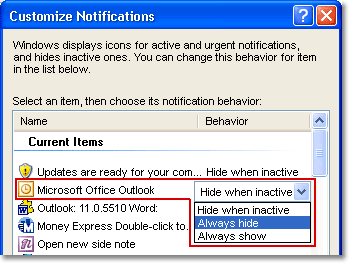Minimize Outlook
By default, all minimized Microsoft Outlook windows and items are displayed on the taskbar. When Outlook is running, the Outlook icon also is displayed by default in the notification area (also known as the system tray) at the far right of the taskbar. You have a few choices for minimizing or displaying Outlook.
What do you want to do?
Minimize Outlook to the taskbar
Note: The notification area feature was introduced with Microsoft Windows XP and is not available in Microsoft Windows 2000 or earlier. The notification area is also known as the system tray.
-
On the title bar of the active window, click Minimize
 . The program window is minimized to a button on the taskbar.
. The program window is minimized to a button on the taskbar.
You can change the default setting to hide the taskbar button, so that it only shows as an icon in the notification area. You can also hide the icon in the notification area.

The default settings are to display the Outlook taskbar buttons and icon. Therefore, if you are not seeing an Outlook button or icon, it might have been turned off.
Show or hide the Outlook taskbar button on the taskbar
You can hide the Outlook taskbar buttons to conserve space on your taskbar. When you hide the Outlook buttons, the Outlook icon is displayed only in the notification area at the far right of the taskbar.
-
Right-click the Outlook icon in the notification area, and then on the shortcut menu, click Hide When Minimized.
Show or hide the Outlook icon in the notification area (system tray)
-
Right-click the notification area, and then click Properties on the shortcut menu.
-
On the Taskbar tab, click Customize.
Note: If Customize is unavailable, you must first select the Hide inactive icons check box under Notification area.
-
In the Name column, click Microsoft Office Outlook.
-
In the Behavior column, in the list, click Always hide, Always show, or Hide when inactive.
-
Click OK twice.

No comments:
Post a Comment